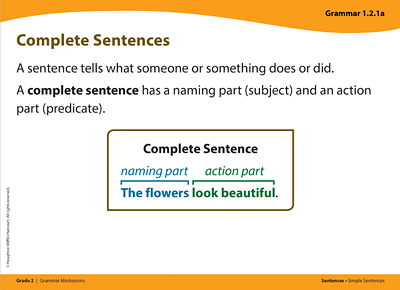Grammar: Complete Sentences
Grammar: Complete Sentences

A complete simple sentence has two parts: a subject and a predicate.
The subject, or naming part, tells who or what did something.
The predicate, or action part, tells what the subject does or did.
- Example: The flowers look beautiful.
To identify whether a simple sentence is complete, ask:
- What is the subject, or naming part, and what is the predicate, or action part?
- ‘The flowers’ is the naming part, and ‘look beautiful’ is the action part.
This simple sentence is complete.
Tell whether each sentence is complete. If the sentence is not complete, tell whether the naming part or the action part is missing.
- Lots of people go to the park. (complete)
- Played on the swings. (incomplete; needs the naming part)
- My family. (incomplete; needs the action part)
- We brought a picnic lunch. (complete)
- Ran a race. (incomplete; needs the naming part)
- Many children. (incomplete; needs the action part)
For additional practice, you may complete the Complete Sentences handout
Texas Tech K-12
-
Address
Texas Tech Plaza | 1901 University Ave, Lubbock, TX 79401 -
Phone
(800) 692-6877 -
Email
ttuk12@ttu.edu

